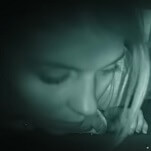This is not to say that there isn’t spectacle. The narrator and filmmakers make a big deal of their capture of a jaguar family (adult male, adult female, adolescent female cub) on film, for what they believe is the first time ever. There are also gorgeous shots of anacondas swimming underwater, and a fish that leaps a foot or two above a river’s surface to snatch some fruit. So the shift toward seeming more educational is primarily one of tone than anything. Secret Brazil is smaller in scope than the spectacle documentaries.
It’s even smaller in scope that NatGeo’s similarly titled Secrets Of Wild India, which aired a few months ago, and whose similar title and apparently similar scope demand comparisons. What separates Secret Brazil from all these other documentaries in a structural sense is that Secret Brazil—despite a title indicating a sweep of the entire, massive nation of Brazil—is its focus on one relatively small region: the Pantanal wetlands, a huge swampy region on the border of Bolivia and Paraguay. The Pantanal has huge swings in seasons. The area floods, then bakes, which gives a variety of different climates and animal behaviors to catch on film.
The two main episodes are each structured around “apex predators,” which are the animals at the top of the food chain. “Jaguar Rising” has plenty of the big cats, while also focusing on the jabiru, a marvelous giant crane, and the cabybara, the world’s largest rodent. “Caiman Cannibals” is filled with odd caiman behavior, while also following anacondas and giant otters. Keeping the predators at the center of the documentary is a good idea for a few reasons. First, these are generally the largest and most “charismatic” animals, which keeps the documentaries interesting. Second, in order to describe how the predators survive, everything below them needs to be examined as well. The jaguar eats the caiman, the caiman eats the fish, the fish eat the fruit, and so on.
Secret Brazil doesn’t achieve that goal. It does a good job of explaining the working of the seasons and how some animals thrive depending on the varying conditions, but the smaller fauna receive little discussion, and the flora is presented by name just once, as one of the trees blooms bright pink. Less of the big animals and more of the smaller ones that keep them alive would have gone a long way. We see a wonderful quick shot of a brightly colored bird startling a beautiful red anteater at a watering hole, but neither of these creatures gets attention from the documentary.
Part of the issue is that Secret Brazil is short. A third episode, “Uncut,” shows how the filmmakers got some of their footage, but it’s largely the same footage we’ve seen previously. That means the final cut lasts for only two hours, and some animals and plants clearly under-served. The airing order is also a little bit odd: “Jaguar Rising” comes first, but “Caiman Cannibal” offers significantly more geographical knowledge about the Pantanal to help put it, and its creatures, into context. This all makes it hard to view Secret Brazil as the kind of documentary that’s going to cross over to a wider audience. But Secret Brazil does offer river otter babies tackling each other to try to get to the cameraman, jaguars copulating and cuddling, caiman babies trying to survive, a surprise freshwater stingray, adorable jabilu chicks wobbling as they learn how to fly, and so on. That’s appealing enough.
Stray observations:
- Another good example of how the doc seems like an educational piece: A tapir is shown and its long snout is described. “It will even act as a snorkel,” says the narrator, which usually implies a cut to that being shown. But there’s no cut. Sometimes Secret Brazil does get that type of material correct, however. The narrator says “quarrels break out” over water when it evaporates leaving only oases. A bird then casually reaches out and pecks an uncaring capybara.
- “Filming jaguars is truly addictive” says one of the filmmakers in “Uncut”—a frightening proposition.








































